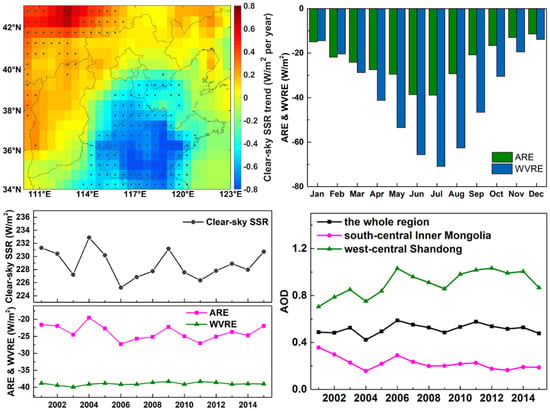Clear-Sky Surface Solar Radiation and the Radiative Effect of Aerosol and Water Vapor Based on Simulations and Satellite Observations over Northern China
Abstract
:1. Introduction
2. Materials and Methods
2.1. Data
2.2. Methodology
2.2.1. Simulation of Clear-Sky SSR and Calculation of ARE and WVRE
2.2.2. Validation of Simulated Clear-Sky SSR
3. Results
3.1. Spatial Pattern of Clear-Sky SSR and Associated Factors in North China
3.2. Seasonal Variation of Clear-Sky SSR and Driving Factors in North China
3.3. Long-Term Trend of Clear-Sky SSR and the Roles of Aerosol and Water Vapor in Northern China
4. Discussion
5. Conclusions
Author Contributions
Funding
Acknowledgments
Conflicts of Interest
References
- Sanchez-Lorenzo, A.; Wild, M. Decadal variations in estimated surface solar radiation over Switzerland since the late 19th century. Atmos. Chem. Phys. Discuss. 2012, 12, 8635–8644. [Google Scholar] [CrossRef] [Green Version]
- Wild, M. Enlightening Global Dimming and Brightening. Bull. Am. Meteorol. Soc. 2012, 93, 27–37. [Google Scholar] [CrossRef]
- Xu, J.; Li, C.; Shi, H.; He, Q.; Pan, L. Analysis on the impact of aerosol optical depth on surface solar radiation in the Shanghai megacity, China. Atmos. Chem. Phys. Discuss. 2011, 11, 3281–3289. [Google Scholar] [CrossRef] [Green Version]
- Valipour, M. Importance of solar radiation, temperature, relative humidity, and wind speed for calculation of reference evapotranspiration. Arch. Agron. Soil Sci. 2014, 61, 239–255. [Google Scholar] [CrossRef]
- Ren, X.; He, H.; Zhang, L.; Yu, G.-R. Global radiation, photosynthetically active radiation, and the diffuse component dataset of China, 1981–2010. Earth Syst. Sci. Data 2018, 10, 1217–1226. [Google Scholar] [CrossRef] [Green Version]
- Europe, S.P. Global Market Outlook for Solar Power 2019–2023; SolarPower Europe: Brussels, Belgium, 2019. [Google Scholar]
- Qian, Y.; Wang, W.; Leung, L.R.; Kaiser, D.P. Variability of solar radiation under cloud-free skies in China: The role of aerosols. Geophys. Res. Lett. 2007, 34. [Google Scholar] [CrossRef]
- Shi, G.-Y.; Hayasaka, T.; Ohmura, A.; Chen, Z.-H.; Wang, B.; Zhao, J.-Q.; Che, H.; Xu, L. Data Quality Assessment and the Long-Term Trend of Ground Solar Radiation in China. J. Appl. Meteorol. Clim. 2008, 47, 1006–1016. [Google Scholar] [CrossRef]
- Karakoti, I.; Pathak, P.P.; Nandan, H. A Comprehensive Study of Ground Measurement and Satellite-Derived Data of Global and Diffuse Radiation. Environ. Prog. Sustain. Energy 2018, 38, e13060. [Google Scholar] [CrossRef]
- Fröhlich, C. Variability of the solar “constant” on time scales of minutes to years. J. Geophys. Res. Space Phys. 1987, 92, 796. [Google Scholar] [CrossRef]
- Liepert, B.G. Observed reductions of surface solar radiation at sites in the United States and worldwide from 1961 to 1990. Geophys. Res. Lett. 2002, 29, 61. [Google Scholar] [CrossRef] [Green Version]
- Abakumova, G.M.; Feigelson, E.M.; Russak, V.; Stadnik, V.V. Evaluation of Long-Term Changes in Radiation, Cloudiness, and Surface Temperature on the Territory of the Former Soviet Union. J. Clim. 1996, 9, 1319–1327. [Google Scholar] [CrossRef] [Green Version]
- Li, J.; Yu, R.; Zhou, T.; Wang, B. Why Is There an Early Spring Cooling Shift Downstream of the Tibetan Plateau? J. Clim. 2005, 18, 4660–4668. [Google Scholar] [CrossRef] [Green Version]
- Kaiser, D.P. Decreasing cloudiness over China: An updated analysis examining additional variables. Geophys. Res. Lett. 2000, 27, 2193–2196. [Google Scholar] [CrossRef] [Green Version]
- Haywood, J.; Bellouin, N.; Jones, A.; Boucher, O.; Wild, M.; Shine, K.P. The roles of aerosol, water vapor and cloud in future global dimming/brightening. J. Geophys. Res. Space Phys. 2011, 116, 116. [Google Scholar] [CrossRef] [Green Version]
- Wild, M.; Trüssel, B.; Ohmura, A.; Long, C.N.; König-Langlo, G.; Dutton, E.G.; Tsvetkov, A. Global dimming and brightening: An update beyond 2000. J. Geophys. Res. Space Phys. 2009, 114, 114. [Google Scholar] [CrossRef] [Green Version]
- Malm, W.C.; Walther, E.G.; Cudney, R.A. The Effects of Water Vapor, Ozone and Aerosol on Atmospheric Turbidity. J. Appl. Meteorol. 1977, 16, 268–274. [Google Scholar] [CrossRef] [Green Version]
- Satheesh, S.K.; Ramanathan, V. Large differences in tropical aerosol forcing at the top of the atmosphere and Earth’s surface. Nature 2000, 405, 60–63. [Google Scholar] [CrossRef]
- Kanakidou, M.; Seinfeld, J.H.; Pandis, S.N.; Barnes, I.; Dentener, F.J.; Facchini, M.C.; van Dingenen, R.; Ervens, B.; Nenes, A.; Nielsen, C.J.; et al. Organic aerosol and global climate modelling: A review. Atmos. Chem. Phys. Discuss. 2004, 4, 5855–6024. [Google Scholar] [CrossRef] [Green Version]
- Radke, L.F.; Coakley, J.A.; King, M.D. Direct and Remote Sensing Observations of the Effects of Ships on Clouds. Science 1989, 246, 1146–1149. [Google Scholar] [CrossRef] [Green Version]
- Andreae, M.O.; Rosenfeld, D. Aerosol–cloud–precipitation interactions. Part 1. The nature and sources of cloud-active aerosols. Earth-Sci. Rev. 2008, 89, 13–41. [Google Scholar] [CrossRef]
- Norris, J.R.; Wild, M. Trends in aerosol radiative effects over Europe inferred from observed cloud cover, solar “dimming,” and solar “brightening”. J. Geophys. Res. Space Phys. 2007, 112. [Google Scholar] [CrossRef] [Green Version]
- Qian, Y.; Kaiser, D.P.; Leung, L.R.; Xu, M. More frequent cloud-free sky and less surface solar radiation in China from 1955 to 2000. Geophys. Res. Lett. 2006, 33. [Google Scholar] [CrossRef] [Green Version]
- Tzanis, C.G.; Varotsos, C. Tropospheric aerosol forcing of climate: A case study for the greater area of Greece. Int. J. Remote. Sens. 2008, 29, 2507–2517. [Google Scholar] [CrossRef]
- Boucher, O.; Pham, M. History of sulfate aerosol radiative forcings. Geophys. Res. Lett. 2002, 29. [Google Scholar] [CrossRef]
- Kaufman, Y.J.; Tanre, D.; Holben, B.N.; Mattoo, S.; Remer, L.A.; Eck, T.F.; Vaughan, J.; Chatenet, B. Aerosol Radiative Impact on Spectral Solar Flux at the Surface, Derived from Principal-Plane Sky Measurements. J. Atmos. Sci. 2002, 59, 635–646. [Google Scholar] [CrossRef] [Green Version]
- Obregón, M.A.; Costa, M.J.; Serrano, A.; Silva, A.M. Effect of water vapor in the SW and LW downward irradiance at the surface during a day with low aerosol load. In Proceedings of the IOP Conference Series: Earth and Environmental Science, Elche, Spain, 29 June–1 July 2015; IOP Publishing: Bristol, UK, 2015; p. 12009. [Google Scholar]
- Hakuba, M.Z.; Folini, D.; Wild, M. On the Zonal Near-Constancy of Fractional Solar Absorption in the Atmosphere. J. Clim. 2016, 29, 3423–3440. [Google Scholar] [CrossRef]
- Donohoe, A.; Battisti, D.S. What Determines Meridional Heat Transport in Climate Models? J. Clim. 2012, 25, 3832–3850. [Google Scholar] [CrossRef]
- Schwarz, M.; Folini, D.; Yang, S.; Wild, M. The Annual Cycle of Fractional Atmospheric Shortwave Absorption in Observations and Models: Spatial Structure, Magnitude, and Timing. J. Clim. 2019, 32, 6729–6748. [Google Scholar] [CrossRef]
- Fu, D.; Song, Z.; Zhang, X.; Xia, X.; Wang, J.; Che, H.; Wu, H.; Tang, X.; Zhang, J.; Duan, M. Mitigating MODIS AOD non-random sampling error on surface PM2.5 estimates by a combined use of Bayesian Maximum Entropy method and linear mixed-effects model. Atmos. Pollut. Res. 2020, 11, 482–490. [Google Scholar] [CrossRef]
- Song, Z.; Fu, D.; Zhang, X.; Wu, Y.; Xia, X.; He, J.; Han, X.; Zhang, R.; Che, H. Diurnal and seasonal variability of PM2.5 and AOD in North China plain: Comparison of MERRA-2 products and ground measurements. Atmos. Environ. 2018, 191, 70–78. [Google Scholar] [CrossRef]
- Zhang, J.; Xia, X.; Zong, X.; Fan, X.; Chen, H.; Li, J. Dust Properties and Radiative Impacts at a Suburban Site during 2004–2017 in the North China Plain. Remote. Sens. 2019, 11, 1842. [Google Scholar] [CrossRef] [Green Version]
- Cao, L.Q.; Yu, J.H.; Ge, Z.X. Water vapor content in the atmosphere and its variation trend over North China. Adv. Water Sci. 2005, 16, 439–443. [Google Scholar] [CrossRef]
- Zhang, X.; Xia, X.; Xuan, C. On the drivers of variability and trend of surface solar radiation in Beijing metropolitan area. Int. J. Clim. 2014, 35, 452–461. [Google Scholar] [CrossRef]
- Song, J.; Xia, X.; Che, H.; Wang, J.; Zhang, X.; Li, X. Daytime variation of aerosol optical depth in North China and its impact on aerosol direct radiative effects. Atmos. Environ. 2018, 182, 31–40. [Google Scholar] [CrossRef]
- Che, H.; Xia, X.; Zhu, J.; Li, Z.; Dubovik, O.; Holben, B.; Goloub, P.; Chen, H.; Estelles, V.; Cuevas, E.; et al. Column aerosol optical properties and aerosol radiative forcing during a serious haze-fog month over North China Plain in 2013 based on ground-based sunphotometer measurements. Atmos. Chem. Phys. Discuss. 2014, 14, 2125–2138. [Google Scholar] [CrossRef] [Green Version]
- King, M.D.; Menzel, W.P.; Kaufman, Y.; Tanre, D.; Gao, B.-C.; Platnick, S.; Ackerman, S.; Remer, L.; Pincus, R.; Hubanks, P. Cloud and aerosol properties, precipitable water, and profiles of temperature and water vapor from MODIS. IEEE Trans. Geosci. Remote. Sens. 2003, 41, 442–458. [Google Scholar] [CrossRef] [Green Version]
- Levy, R.C.; Mattoo, S.; Munchak, L.A.; Remer, L.A.; Sayer, A.M.; Patadia, F.; Hsu, N.C. The Collection 6 MODIS aerosol products over land and ocean. Atmos. Meas. Tech. 2013, 6, 2989–3034. [Google Scholar] [CrossRef] [Green Version]
- Sayer, A.M.; Munchak, L.A.; Hsu, N.C.; Levy, R.C.; Bettenhausen, C.; Jeong, M.-J. MODIS Collection 6 aerosol products: Comparison between Aqua’s e-Deep Blue, Dark Target, and “merged” data sets, and usage recommendations. J. Geophys. Res. Atmos. 2014, 119, 13965–13989. [Google Scholar] [CrossRef]
- Ruiz-Arias, J.A.; Dudhia, J.; Gueymard, C.A.; Pozo-Vazquez, D. Assessment of the Level-3 MODIS daily aerosol optical depth in the context of surface solar radiation and numerical weather modeling. Atmos. Chem. Phys. Discuss. 2013, 13, 675–692. [Google Scholar] [CrossRef] [Green Version]
- Kinne, S.; Schulz, M.; Textor, C.; Guibert, S.; Balkanski, Y.; Bauer, S.E.; Berntsen, T.; Berglen, T.F.; Boucher, O.; Chin, M.; et al. An AeroCom initial assessment—Optical properties in aerosol component modules of global models. Atmos. Chem. Phys. Discuss. 2006, 6, 1815–1834. [Google Scholar] [CrossRef] [Green Version]
- Lacagnina, C.; Hasekamp, O.P.; Bian, H.S.; Curci, G.; Myhre, G.; van Noije, T.; Schulz, M.; Skeie, R.B.; Takemura, T.; Zhang, K. Aerosol single-scattering albedo over the global oceans: Comparing PARASOL retrievals with AERONET, OMI, and AeroCom models estimates. J. Geophys. Res. Atmos. 2015, 120, 9814–9836. [Google Scholar] [CrossRef] [Green Version]
- Holben, B.; Eck, T.; Slutsker, I.; Tanre, D.; Buis, J.; Setzer, A.; Vermote, E.; Reagan, J.; Kaufman, Y.; Nakajima, T.; et al. AERONET—A Federated Instrument Network and Data Archive for Aerosol Characterization. Remote. Sens. Environ. 1998, 66, 1–16. [Google Scholar] [CrossRef]
- Boilley, A.; Wald, L. Comparison between meteorological re-analyses from ERA-Interim and MERRA and measurements of daily solar irradiation at surface. Renew. Energy 2015, 75, 135–143. [Google Scholar] [CrossRef]
- Zhang, Y.; Cai, C.; Chen, B.; Dai, W. Consistency Evaluation of Precipitable Water Vapor Derived from ERA5, ERA-Interim, GNSS, and Radiosondes Over China. Radio Sci. 2019, 54, 561–571. [Google Scholar] [CrossRef]
- Gelaro, R.; Mccarty, W.; Suárez, M.J.; Todling, R.; Molod, A.; Takacs, L.; Randles, C.; Darmenov, A.; Bosilovich, M.G.; Reichle, R.H.; et al. The Modern-Era Retrospective Analysis for Research and Applications, Version 2 (MERRA-2). J. Clim. 2017, 30, 5419–5454. [Google Scholar] [CrossRef] [PubMed]
- Molod, A.; Takács, L.; Suárez, M.; Bacmeister, J. Development of the GEOS-5 atmospheric general circulation model: Evolution from MERRA to MERRA2. Geosci. Model Dev. 2015, 8, 1339–1356. [Google Scholar] [CrossRef] [Green Version]
- Müller, R.; Matsoukas, C.; Gratzki, A.; Behr, H.; Hollmann, R. The CM-SAF operational scheme for the satellite based retrieval of solar surface irradiance—A LUT based eigenvector hybrid approach. Remote. Sens. Environ. 2009, 113, 1012–1024. [Google Scholar] [CrossRef]
- Emde, C.; Buras-Schnell, R.; Kylling, A.; Mayer, B.; Gasteiger, J.; Hamann, U.; Kylling, J.; Richter, B.; Pause, C.; Dowling, T.; et al. The libRadtran software package for radiative transfer calculations (Version 2.0). Geosci. Model Dev. Discuss. 2015, 8, 10237–10303. [Google Scholar] [CrossRef] [Green Version]
- Christopher, S.; Zhang, J.; Kaufman, Y.J.; Remer, L.A. Satellite-based assessment of top of atmosphere anthropogenic aerosol radiative forcing over cloud-free oceans. Geophys. Res. Lett. 2006, 33. [Google Scholar] [CrossRef] [Green Version]
- Silvestre, M.R.; Silvestre, M.R. Temporal decomposition, and harmonic regression models: A comparison to the series of monthly average minimum and maximum temperature at presidente prudente (sp). Rev. Bras. Meteorol. 2015, 30, 157–185. [Google Scholar]
- Levine, D.; Crews, K. Time series harmonic regression analysis reveals seasonal vegetation productivity trends in semi-arid savannas. Int. J. Appl. Earth Obs. Geoinform. 2019, 80, 94–101. [Google Scholar] [CrossRef]
- Weatherhead, E.; Reinsel, G.C.; Tiao, G.C.; Meng, X.-L.; Choi, D.; Cheang, W.-K.; Keller, T.; de Luisi, J.; Wuebbles, D.J.; Kerr, J.B.; et al. Factors affecting the detection of trends: Statistical considerations and applications to environmental data. J. Geophys. Res. Space Phys. 1998, 103, 17149–17161. [Google Scholar] [CrossRef]
- Bartók, B. Aerosol radiative effects under clear skies over Europe and their changes in the period of 2001–2012. Int. J. Clim. 2016, 37, 1901–1909. [Google Scholar] [CrossRef]
- Long, C.N.; Ackerman, T.P. Identification of clear skies from broadband pyranometer measurements and calculation of downwelling shortwave cloud effects. J. Geophys. Res. Space Phys. 2000, 105, 15609–15626. [Google Scholar] [CrossRef]
- Otunla, T.A. Estimates of clear-sky solar irradiances over Nigeria. Renew. Energy 2019, 131, 778–787. [Google Scholar] [CrossRef]
- Zhang, C.; Wen, M. Using Satellite Data to Estimate Solar Radiation of Clear Sky over Fujian. J. Nat. Res. 2014, 29, 1496–1507. [Google Scholar]
- Song, Z.; Fu, D.; Zhang, X.; Han, X.; Song, J.; Zhang, J.; Wang, J.; Xia, X. MODIS AOD sampling rate and its effect on PM2.5 estimation in North China. Atmos. Environ. 2019, 209, 14–22. [Google Scholar] [CrossRef]
- Feng, N.; Christopher, S. Clear sky direct radiative effects of aerosols over Southeast Asia based on satellite observations and radiative transfer calculations. Remote. Sens. Environ. 2014, 152, 333–344. [Google Scholar] [CrossRef]
- Marty, C.; Philipona, R.; Fröhlich, C.; Ohmura, A.; Marty, C. Altitude dependence of surface radiation fluxes and cloud forcing in the alps: Results from the alpine surface radiation budget network. Theor. Appl. Clim. 2002, 72, 137–155. [Google Scholar] [CrossRef]
- Qian, X.; Yao, Y.Q.; Li, J.R.; Yin, J.; Ma, J.L. The Distribution of Precipitable Water Vapor over China. Acta Astronom. Sin. 2012, 53, 325–341. [Google Scholar]
- Yu, M.; Ellis, J.E.; Epstein, H.E. Regional Analysis of Climate, Primary Production, and Livestock Density in Inner Mongolia. J. Environ. Qual. 2004, 33, 1675–1681. [Google Scholar] [CrossRef] [PubMed]
- Xia, X.; Chen, H.B.; Wang, P.C.; Zhang, W.X.; Goloub, P.; Chatenet, B.; Eck, T.F.; Holben, B.N. Variation of column-integrated aerosol properties in a Chinese urban region. J. Geophys. Res. Space Phys. 2006, 111, 05204. [Google Scholar] [CrossRef]
- Huang, R.-J.; Zhang, Y.; Bozzetti, C.; Ho, K.F.; Cao, J.; Han, Y.; Daellenbach, K.R.; Slowik, J.G.; Platt, S.; Canonaco, F.; et al. High secondary aerosol contribution to particulate pollution during haze events in China. Nature 2014, 514, 218–222. [Google Scholar] [CrossRef] [PubMed] [Green Version]
- Pani, S.K.; Lin, N.-H.; Chantara, S.; Wang, S.-H.; Khamkaew, C.; Prapamontol, T.; Janjai, S. Radiative response of biomass-burning aerosols over an urban atmosphere in northern peninsular Southeast Asia. Sci. Total. Environ. 2018, 633, 892–911. [Google Scholar] [CrossRef] [PubMed]
- Gautam, R.; Hsu, N.C.; Eck, T.F.; Holben, B.N.; Janjai, S.; Jantarach, T.; Tsay, S.-C.; Lau, W.K. Characterization of aerosols over the Indochina peninsula from satellite-surface observations during biomass burning pre-monsoon season. Atmos. Environ. 2013, 78, 51–59. [Google Scholar] [CrossRef]
- Luo, Y.; Zheng, X.; Zhao, T.; Chen, J. A climatology of aerosol optical depth over China from recent 10 years of MODIS remote sensing data. Int. J. Clim. 2013, 34, 863–870. [Google Scholar] [CrossRef]
- Sun, X.; Wang, P. How old is the Asian monsoon system? Paleobotanical records from China. Palaeogeogr. Palaeoclimatol. Palaeoecol. 2005, 222, 181–222. [Google Scholar] [CrossRef]
- He, J.; Ju, J.; Wen, Z.; Lu, J.; Jin, Q. A review of recent advances in research on Asian monsoon in China. Adv. Atmos. Sci. 2007, 24, 972–992. [Google Scholar] [CrossRef]
- Loeb, N.G.; Su, W. Direct Aerosol Radiative Forcing Uncertainty Based on a Radiative Perturbation Analysis. J. Clim. 2010, 23, 5288–5293. [Google Scholar] [CrossRef]
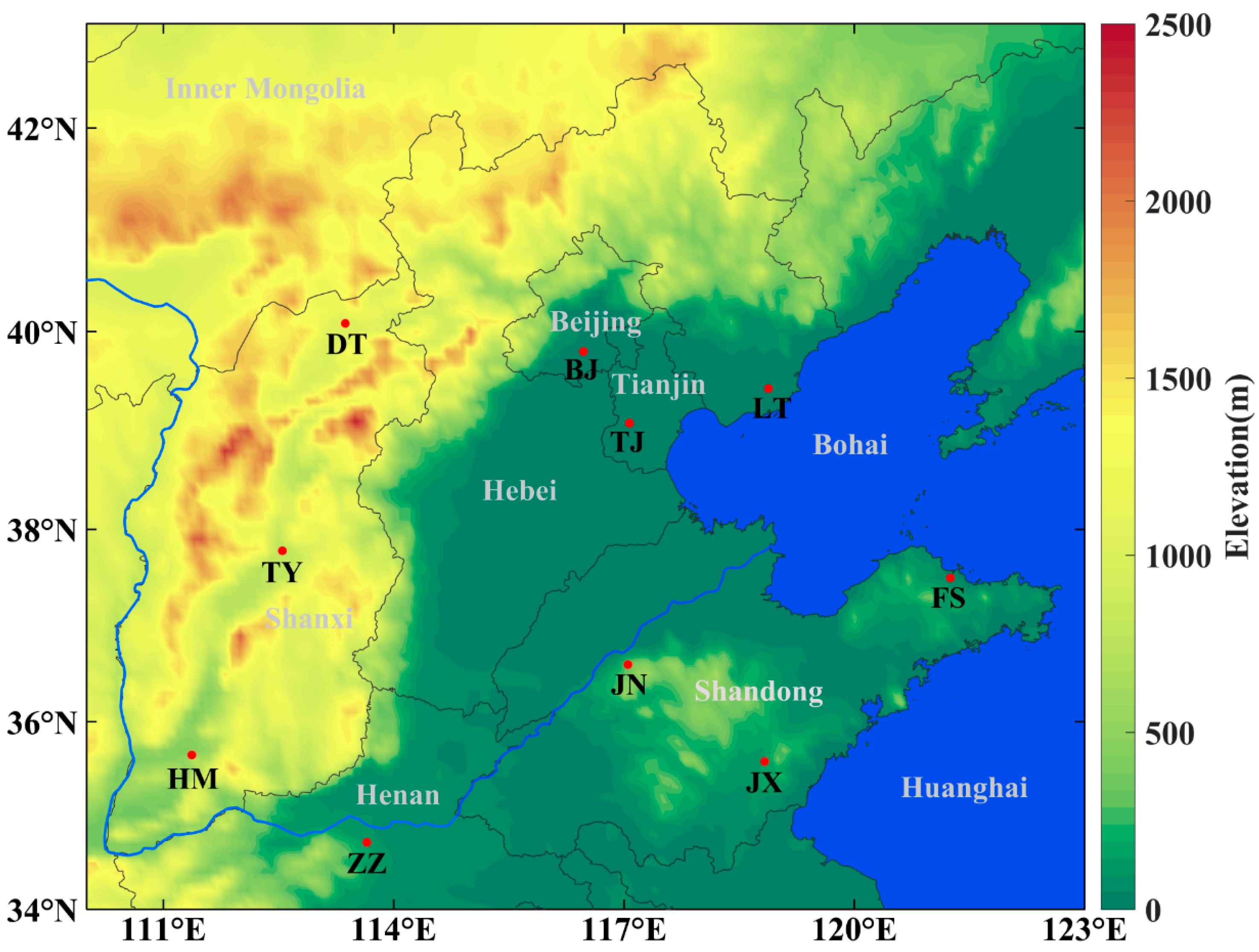
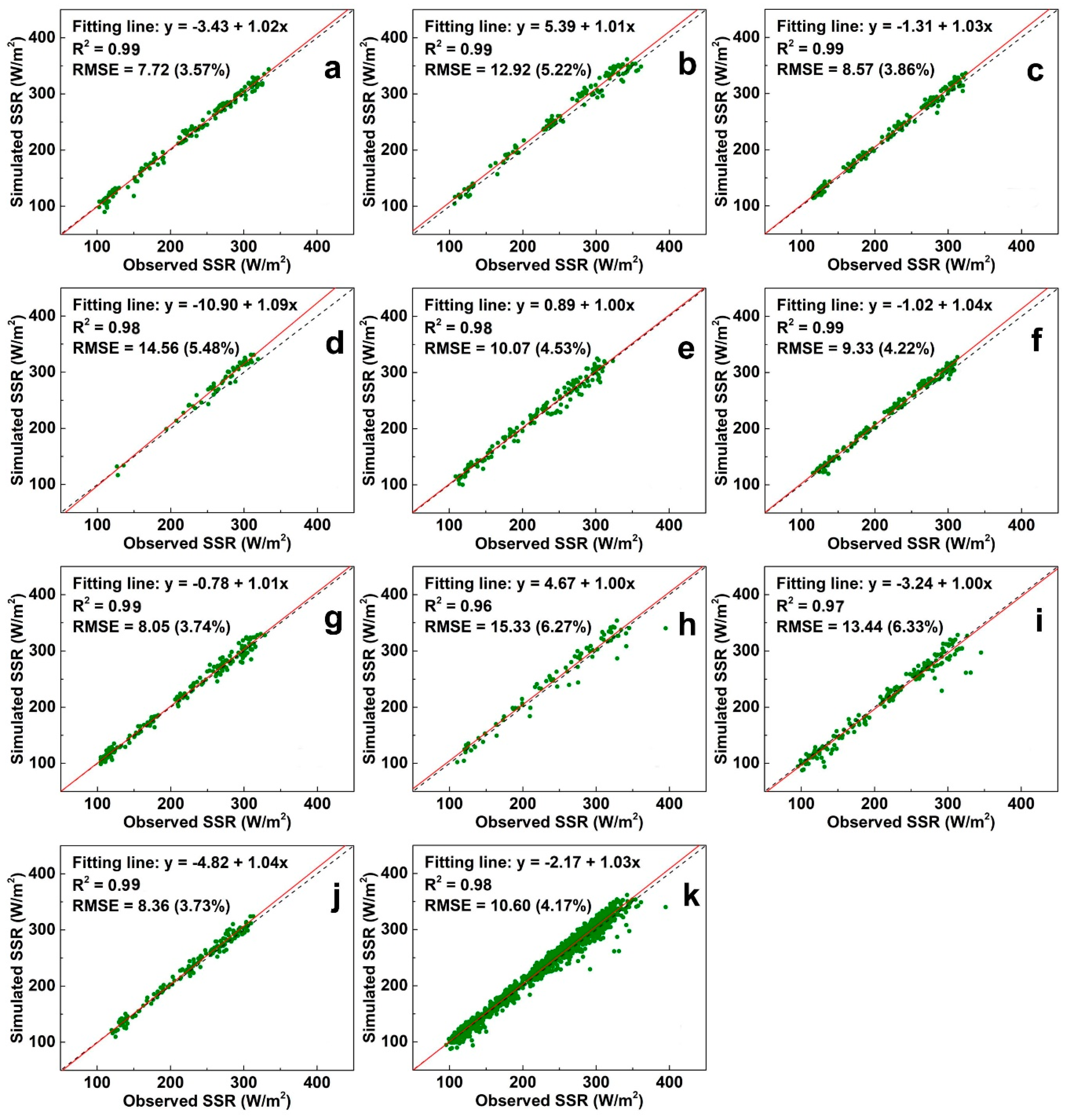
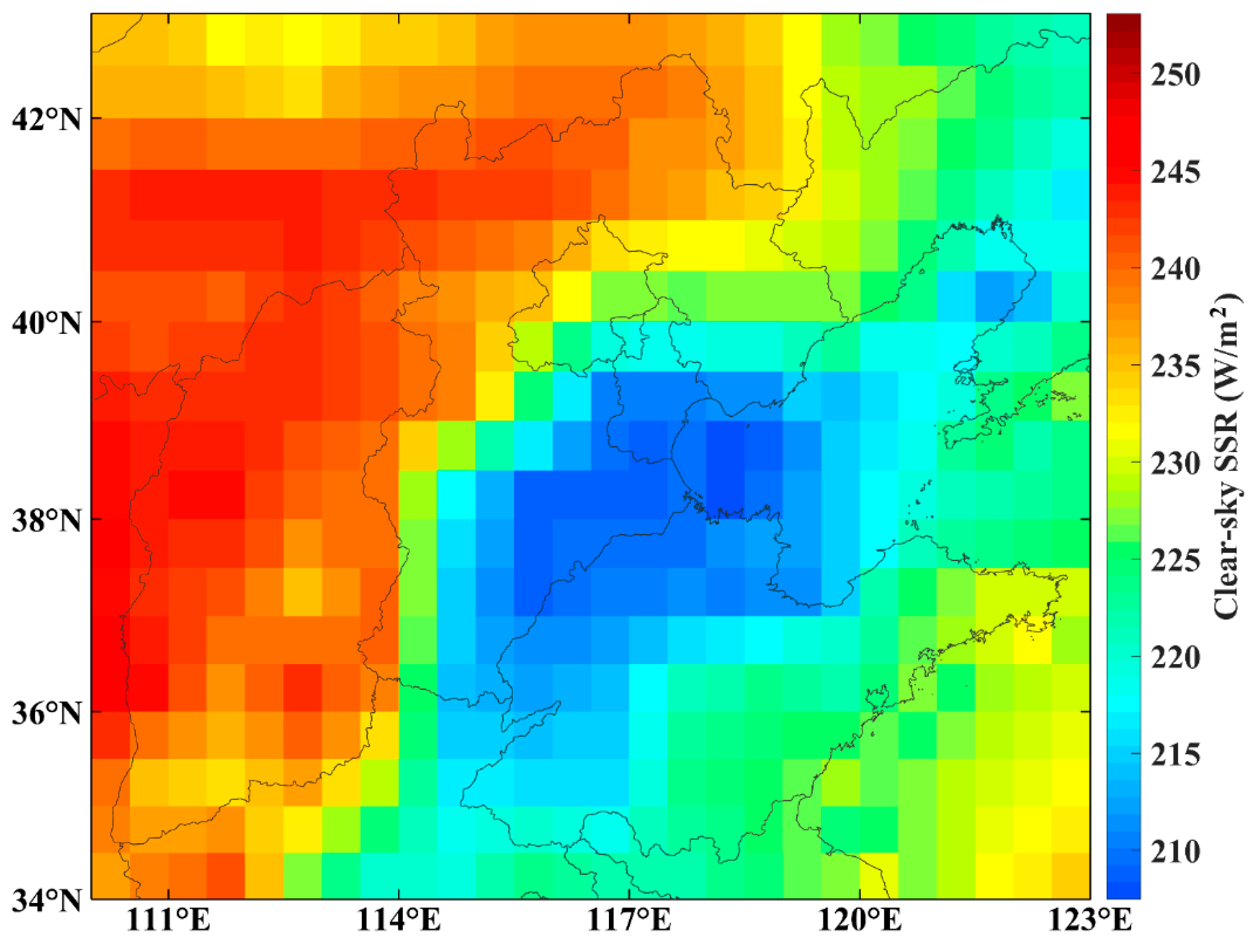
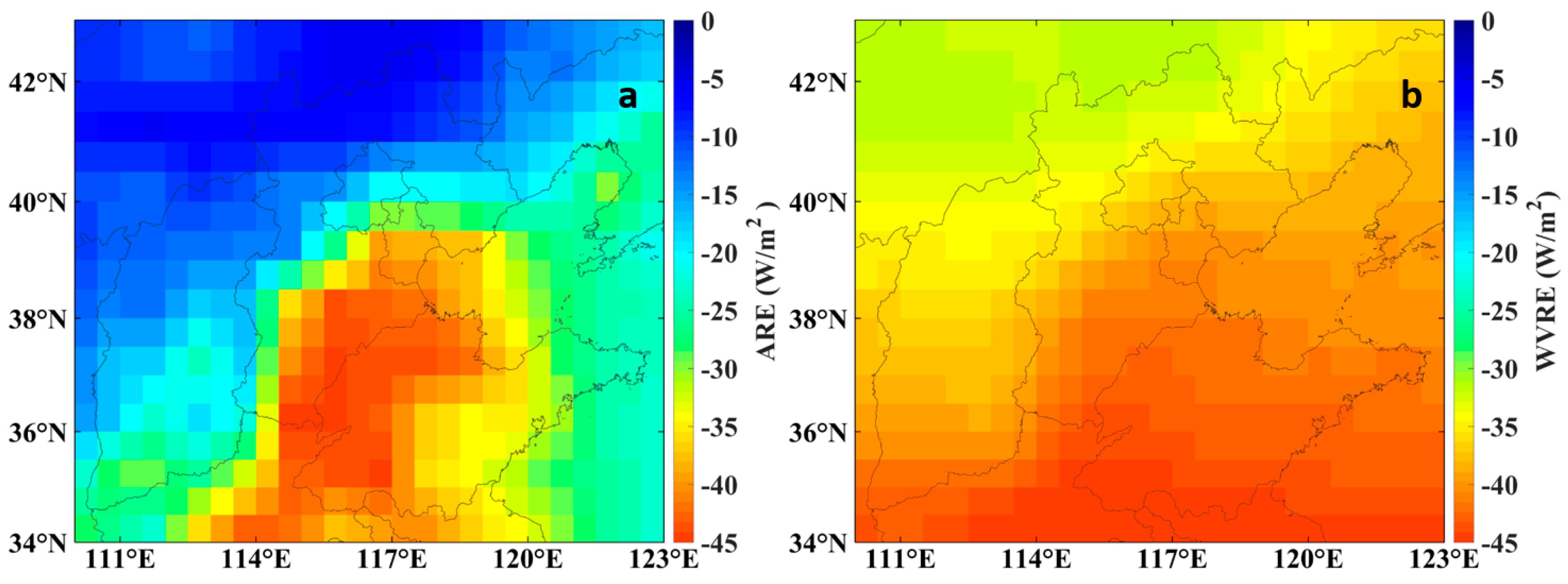
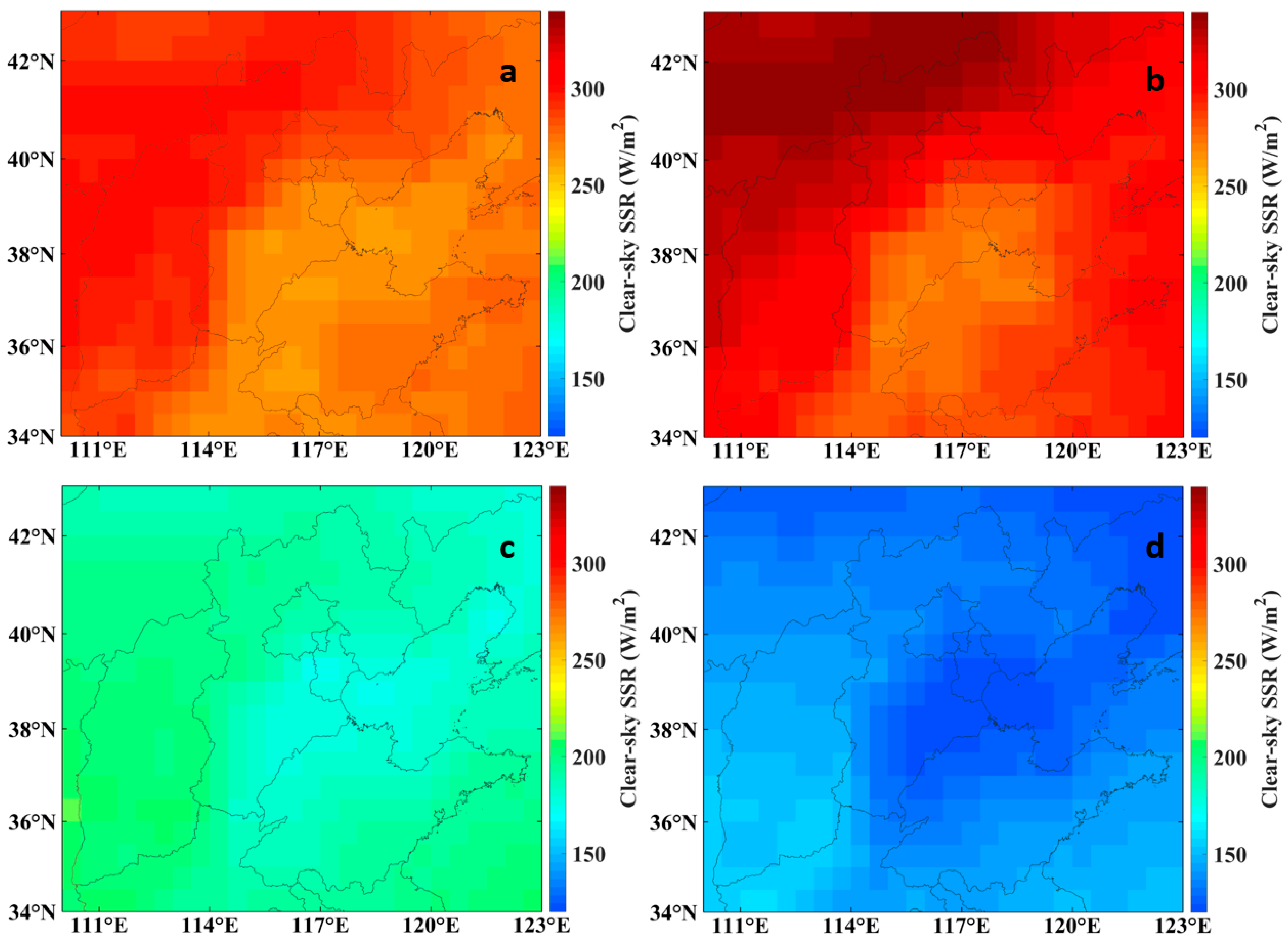
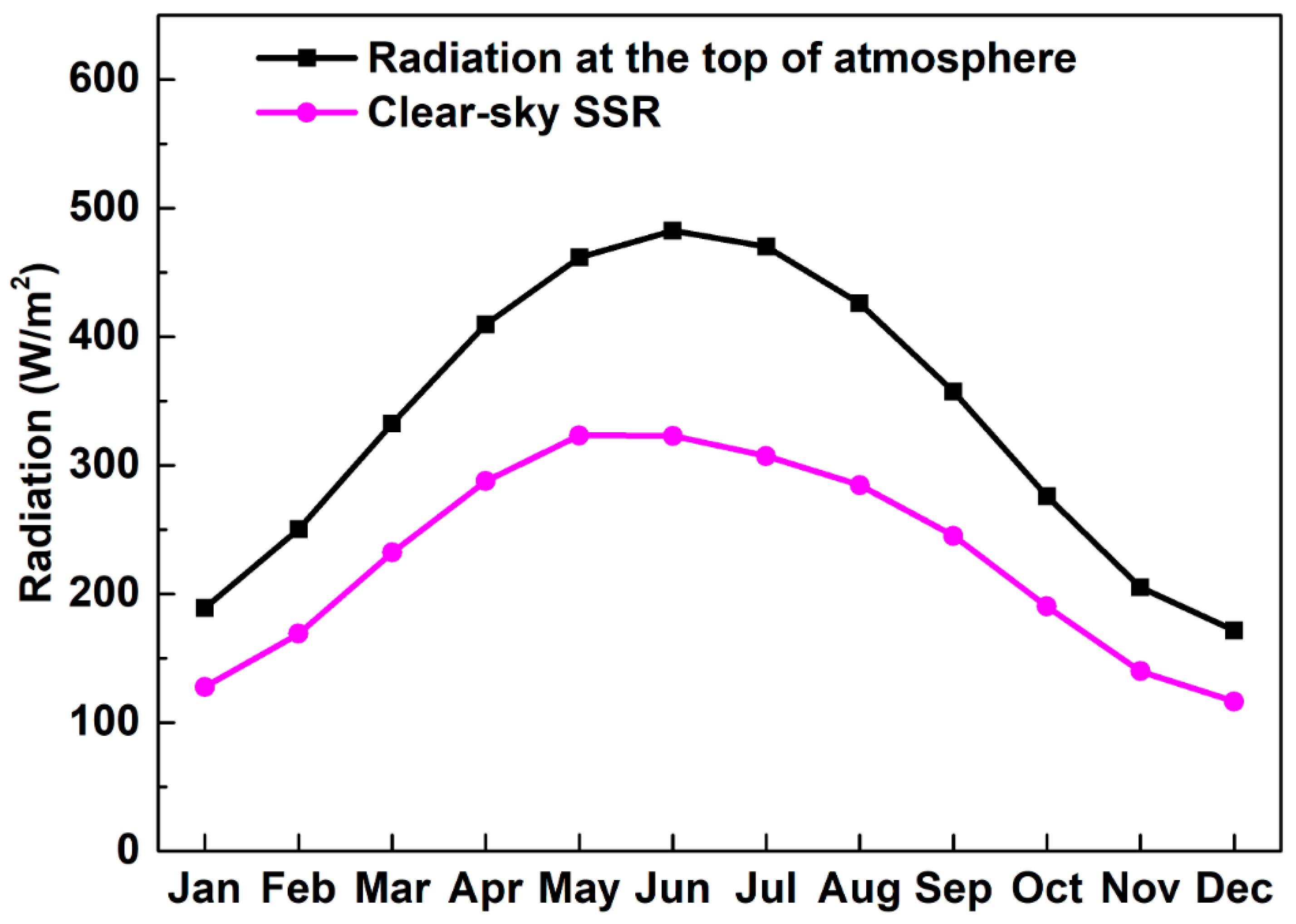
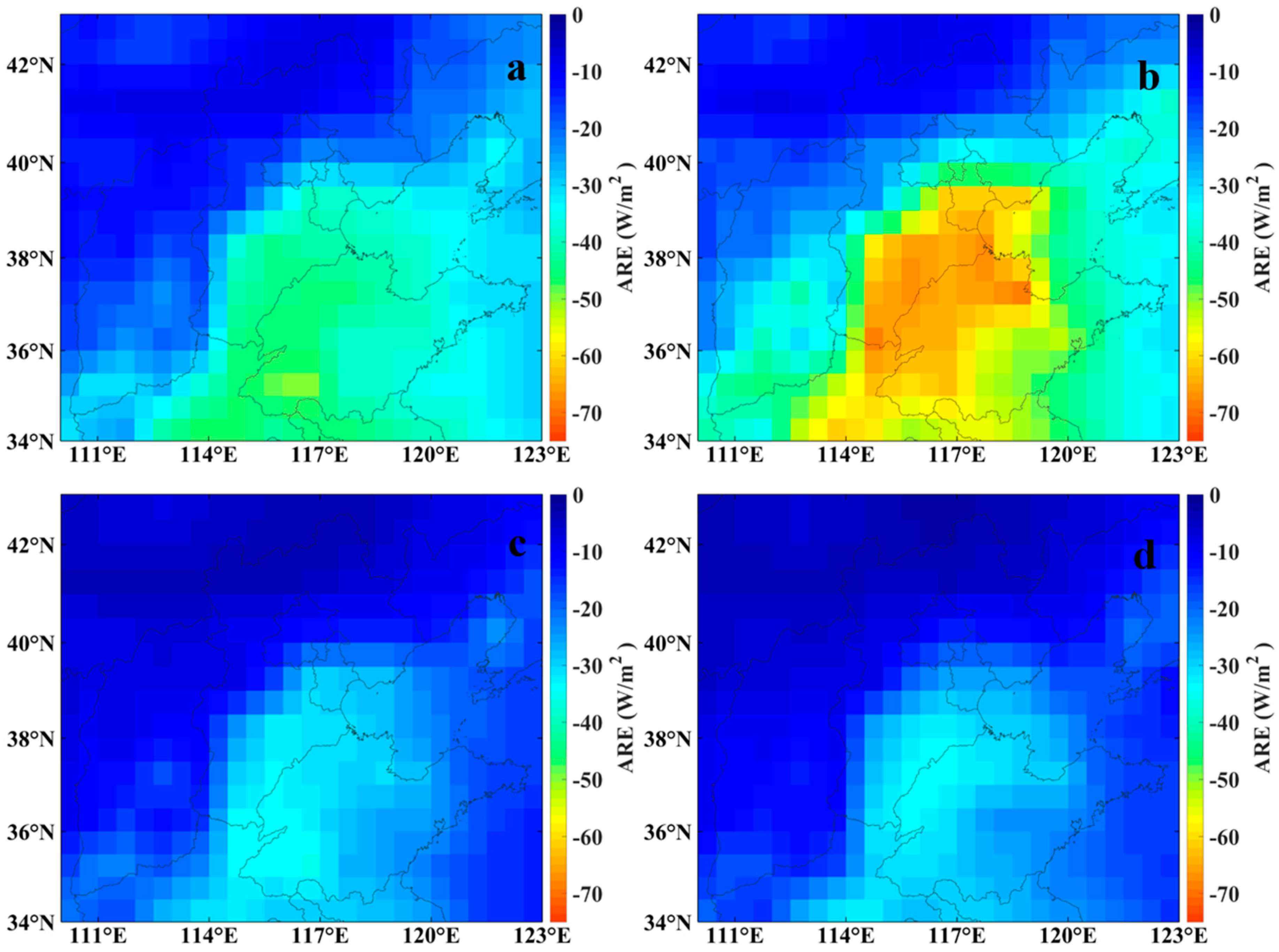
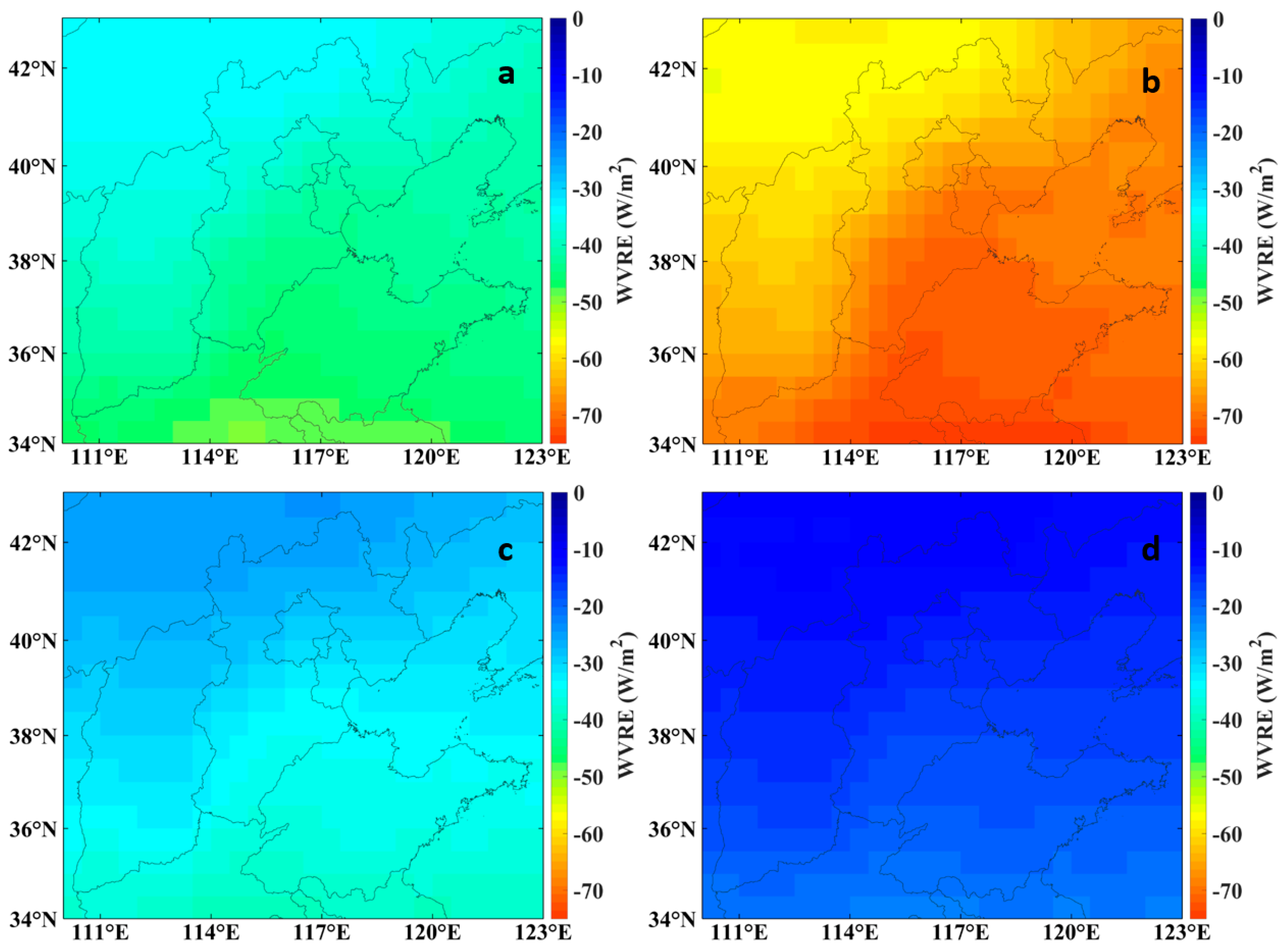


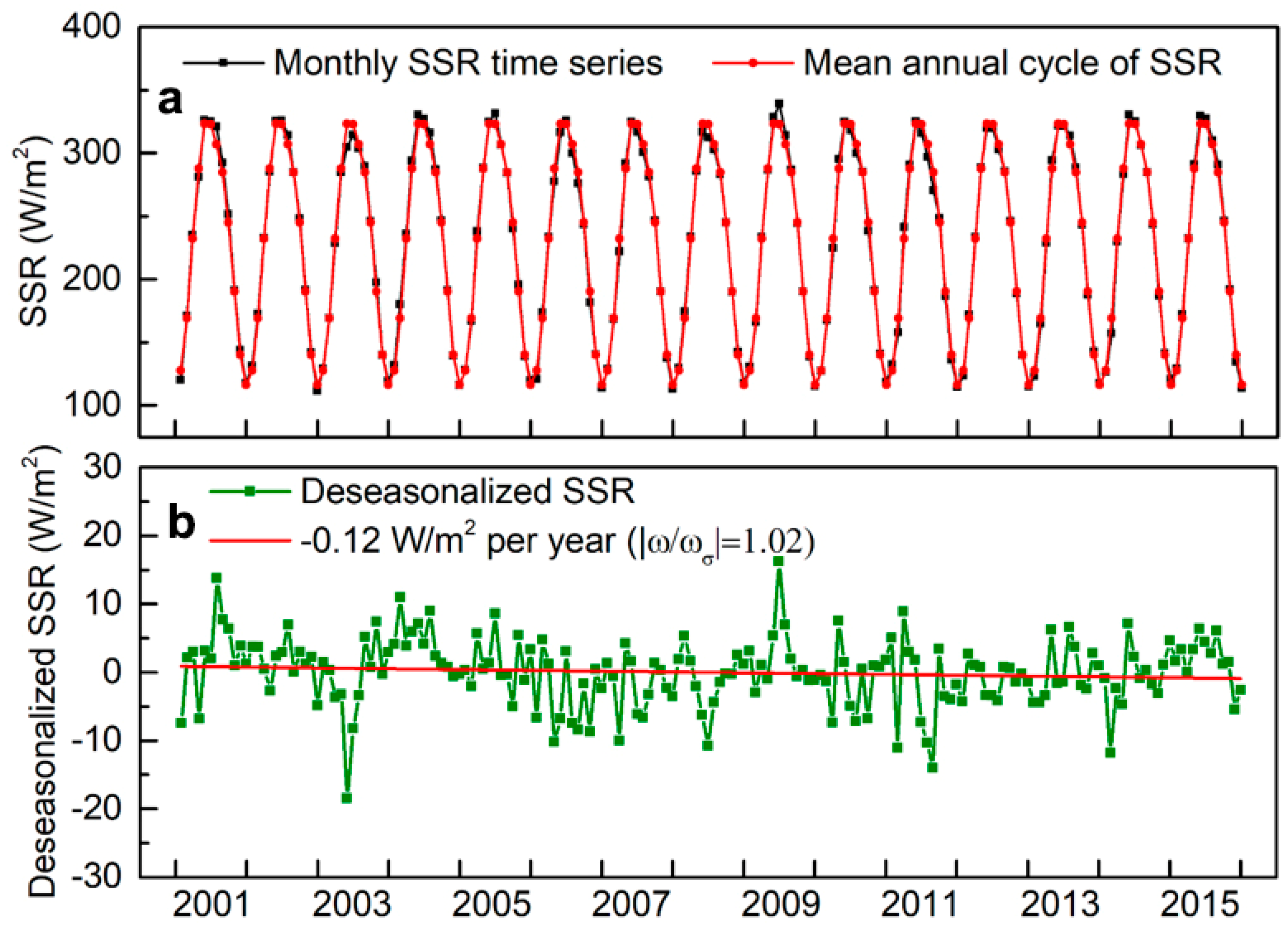
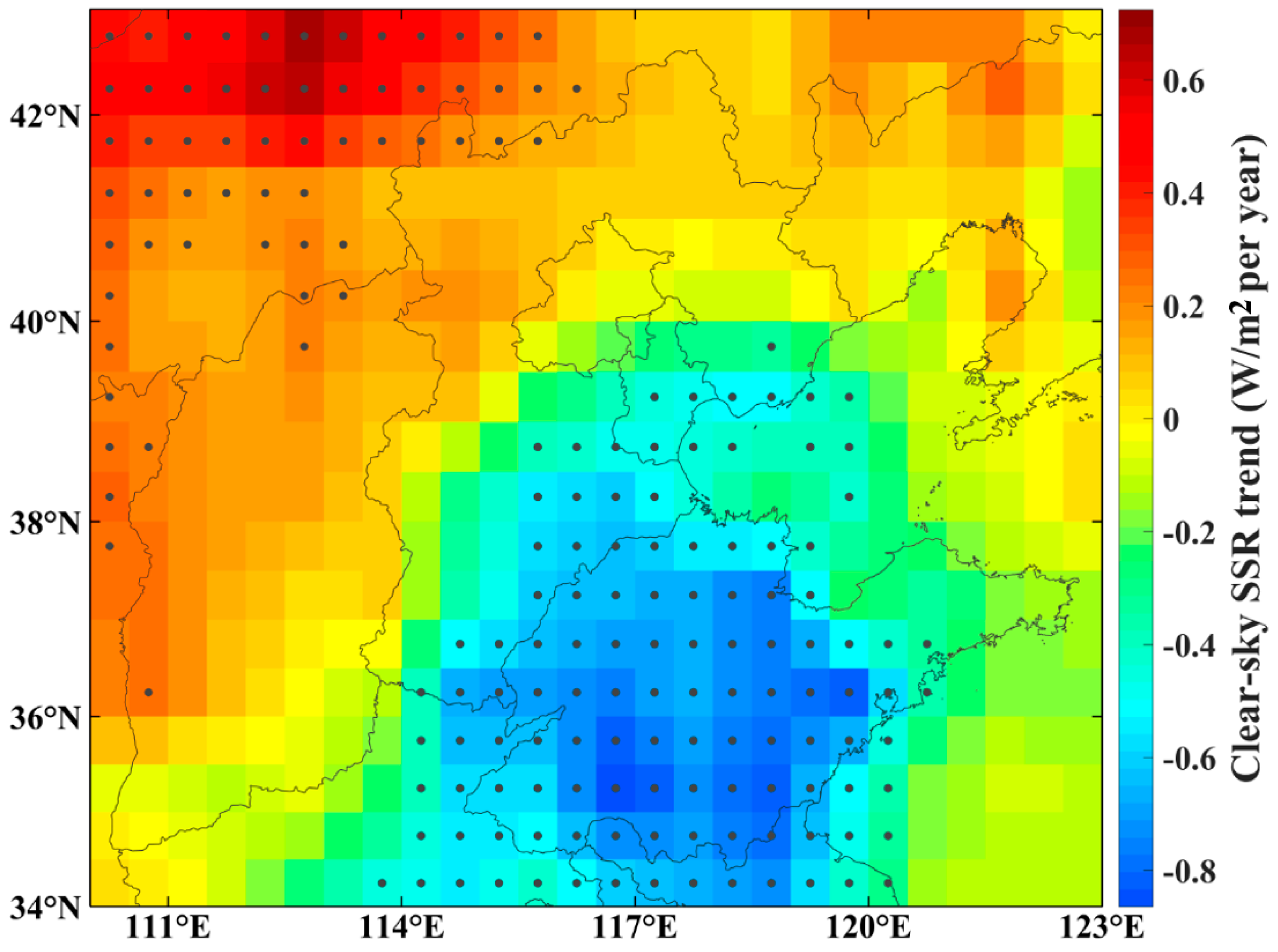
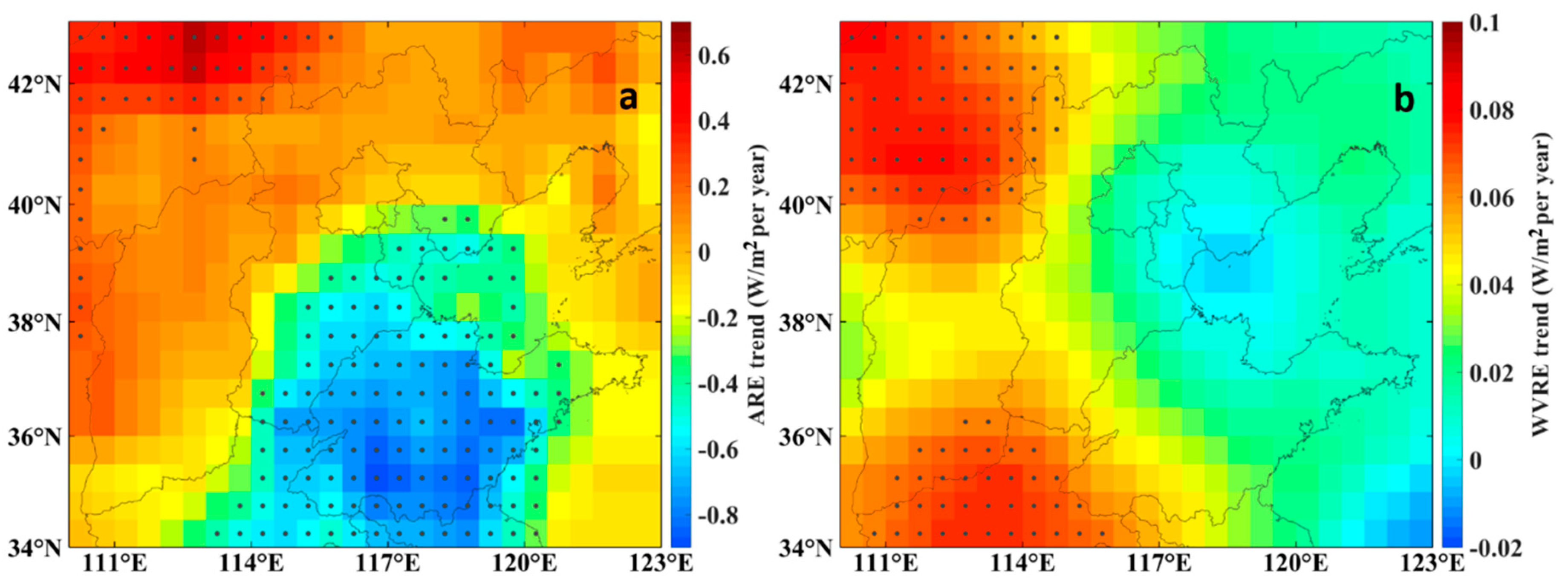
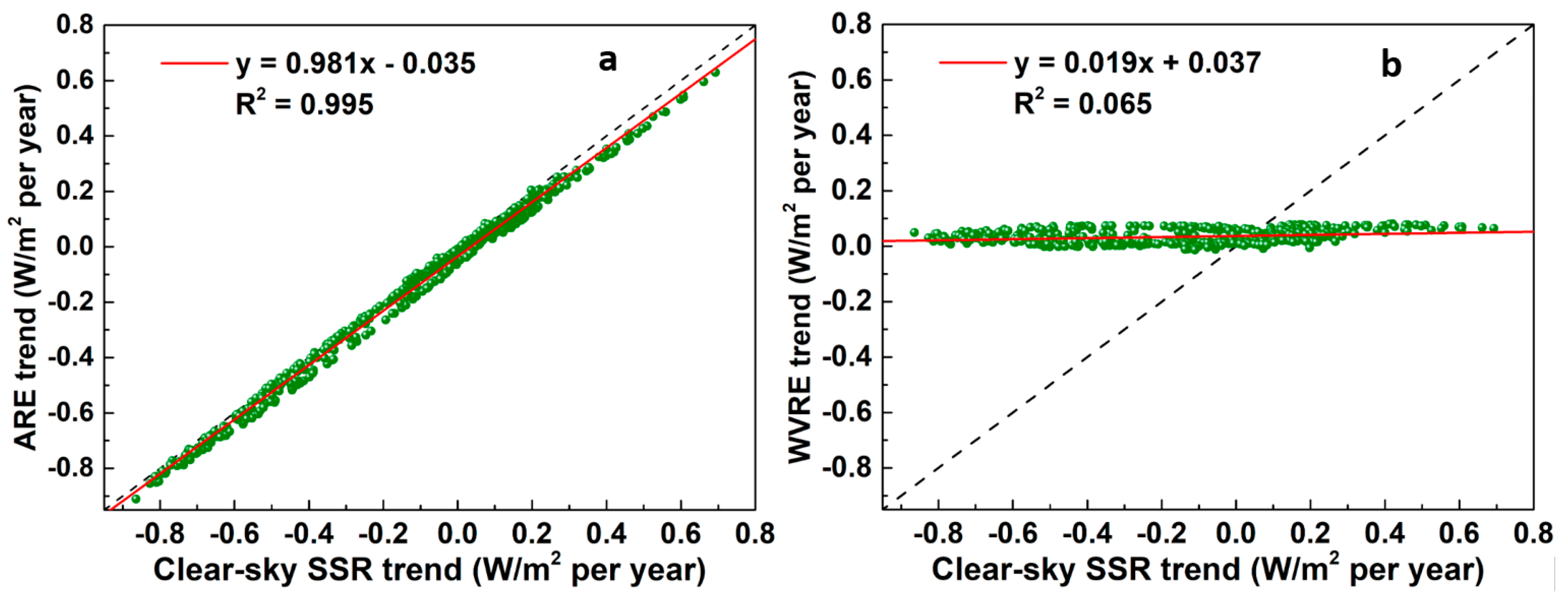
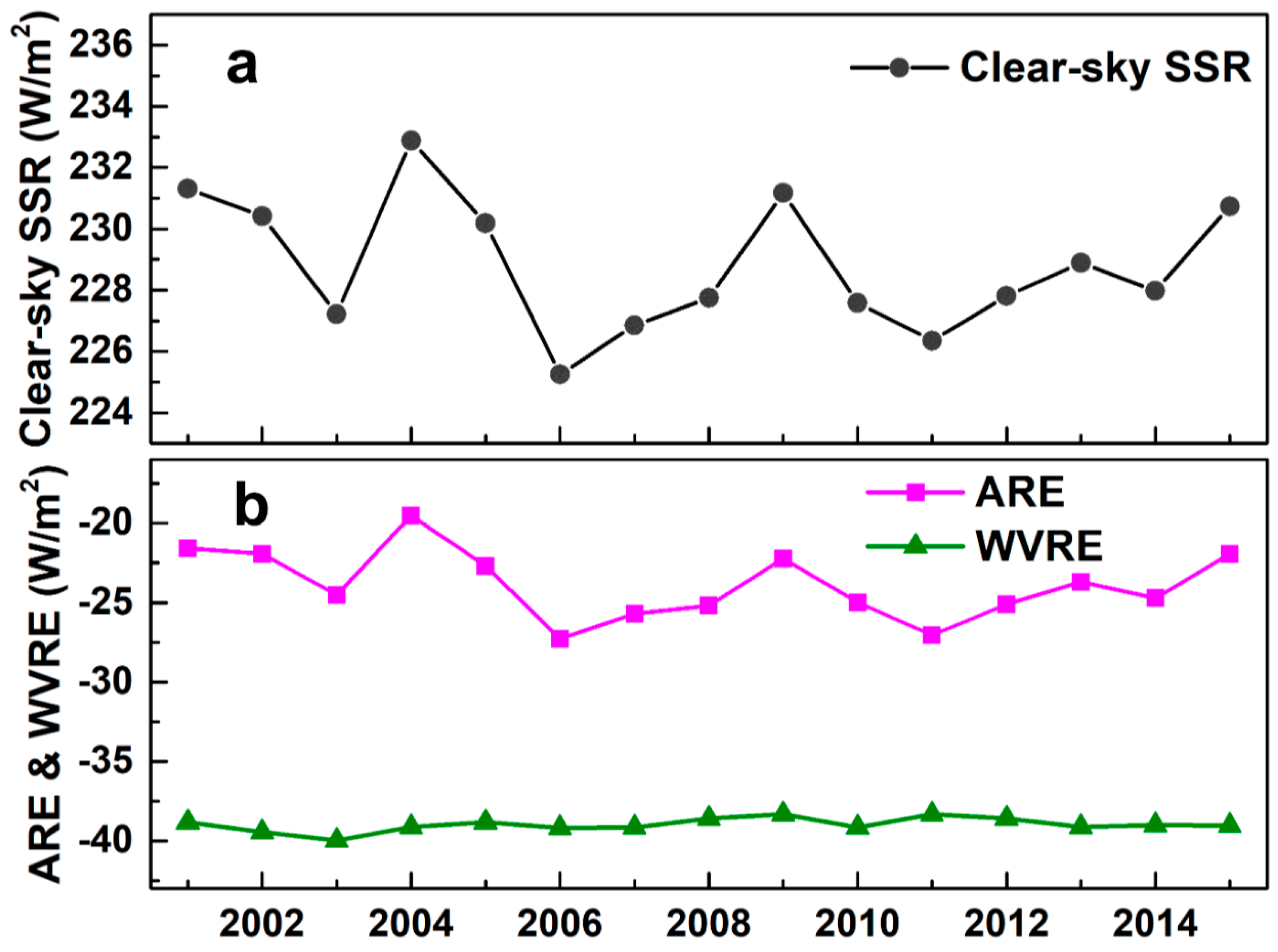

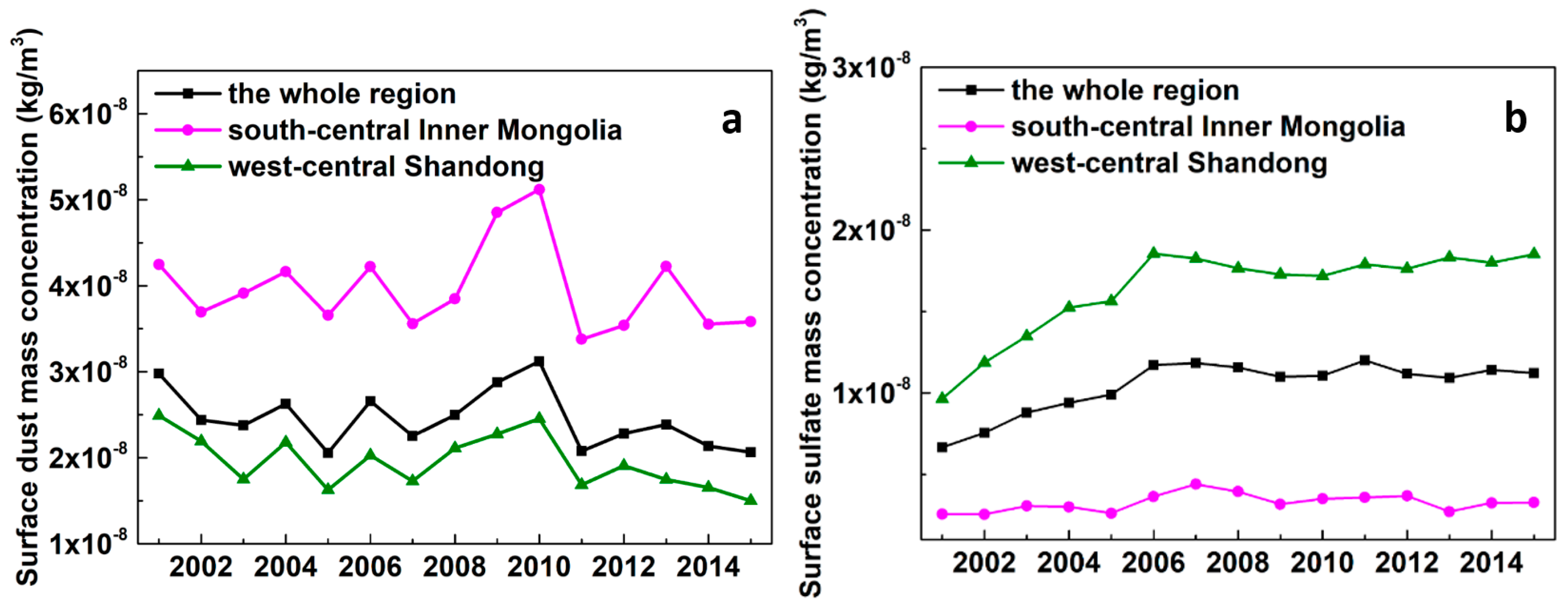
| Stations | Correlation Equation | R2 | MAE (W/m2) | MAE(%) | RMSE (W/m2) | RMSE(%) | Ratio of Clear Sky |
|---|---|---|---|---|---|---|---|
| Datong | y = 1.01x + 5.39 | 0.99 | 10.98 | 4.44% | 12.92 | 5.22% | 25.16% |
| Taiyuan | y = 1.00x + 4.67 | 0.96 | 12.22 | 4.99% | 15.33 | 6.27% | 18.09% |
| Houma | y = 1.09x − 10.90 | 0.98 | 12.98 | 4.87% | 14.56 | 5.48% | 10.88% |
| Beijing | y = 1.02x − 3.43 | 0.99 | 6.25 | 2.89% | 7.72 | 3.57% | 29.12% |
| Tianjin | y = 1.00x − 3.24 | 0.97 | 8.68 | 4.09% | 13.44 | 6.33% | 35.16% |
| Laoting | y = 1.01x − 0.78 | 0.99 | 6.17 | 2.87% | 8.05 | 3.74% | 34.79% |
| Fushan | y = 1.03x − 1.31 | 0.99 | 7.00 | 3.15% | 8.57 | 3.86% | 30.87% |
| Jinan | y = 1.00x + 0.89 | 0.98 | 8.22 | 3.70% | 10.07 | 4.53% | 27.24% |
| JUxian | y = 1.04x − 1.02 | 0.99 | 7.93 | 3.58% | 9.33 | 4.22% | 26.34% |
| Zhengzhou | y = 1.04x − 4.82 | 0.99 | 6.63 | 2.96% | 8.36 | 3.73% | 25.68% |
| all | y = 1.03x − 2.71 | 0.98 | 8.14 | 3.62% | 10.60 | 4.17% | 26.33% |
| Parameter | Perturbation | Change of SSR (W/m2) | Change of SSR (%) |
|---|---|---|---|
| AOD | 0.14|−0.14 | −9.94|10.37 | −3.71|3.87 |
| SSA | 0.06|−0.06 | 12.18|−11.28 | 4.54|−4.21 |
| Water Vapor (kg/m2) | 2.80|−2.80 | −1.72|1.995 | −0.64|0.74 |
© 2020 by the authors. Licensee MDPI, Basel, Switzerland. This article is an open access article distributed under the terms and conditions of the Creative Commons Attribution (CC BY) license (http://creativecommons.org/licenses/by/4.0/).
Share and Cite
Zhang, G.; Ma, Y. Clear-Sky Surface Solar Radiation and the Radiative Effect of Aerosol and Water Vapor Based on Simulations and Satellite Observations over Northern China. Remote Sens. 2020, 12, 1931. https://doi.org/10.3390/rs12121931
Zhang G, Ma Y. Clear-Sky Surface Solar Radiation and the Radiative Effect of Aerosol and Water Vapor Based on Simulations and Satellite Observations over Northern China. Remote Sensing. 2020; 12(12):1931. https://doi.org/10.3390/rs12121931
Chicago/Turabian StyleZhang, Guang, and Yingying Ma. 2020. "Clear-Sky Surface Solar Radiation and the Radiative Effect of Aerosol and Water Vapor Based on Simulations and Satellite Observations over Northern China" Remote Sensing 12, no. 12: 1931. https://doi.org/10.3390/rs12121931



